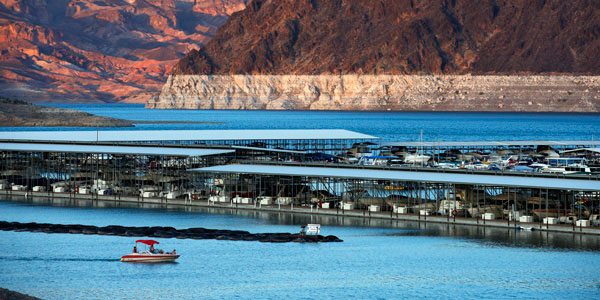Although Arizona may not collectively be singing in the rain, some comfort can be had in knowing that water has been conserved with calculated intention.
In fact, in Arizona State University’s 2011 “Watering the Sun Corridor” report, you’ll find a closing quote stating, “Water, among all things, has been what Arizona does really well.”
But that doesn’t mean we’re out of rough waters just yet.
Supply
“We have been banking water underground for more than a decade,” says Grady Gammage, Jr., partner at Gammage & Burnham. “We’ve been doing it on our own account, but also for California and Nevada, with 10 years worth of water supply.”
Part of this highly variable water supply is due to Salt Water Project’s utilization of reservoirs, making the storage consistent from year to year, according to Christa McJunkin, SRP principal water analyst.
“SRP’s view of ground water,” McJunkin says, “is as something we only have to use.”
Although a substantial reserve of banked-ground water is a positive in terms of Arizona’s prowess in conservation, it isn’t a cure all. In terms of a drought, ground water must be drawn from multiple supply sources, whereas surface water is the main source readily available, as explained by McJunkin.
“Infrastructure is the interconnections from city to city and allows water to be efficiently used, McJunkin says. “It’s important to realize drought does not mean there isn’t enough water to go around.”
Michael Pearce, founding member of what is now Maguire, Pearce & Storey, served as chief counsel for the Arizona Department of Water Resources from 1995 to 2002, and agrees that although Arizona has a diverse water portfolio and solid water supply, there may be room for concern.
“The question is: how much road can we accommodate? In Arizona’s subdivided land and high population counties, you have to show a 100-year supply to get approved (for projects),” Pearce says. “This is one of the highest waiting periods in the country.”
Demand
How will Arizona’s growing infrastructure — in addition to stringent supply regulations — affect water demand in the oncoming years? Beyond these terms, McJunkin points to population. “If you think about what the Valley looked like 20 years ago,” she says, “many places on farms continued to use water, but at a lower rate and similarly, homes utilized less water per acre. We’re not increasing total water use, but replacing it with different types of usage.”
When examining water supply and demand, what do the experts say in regard to sources like Lake Havasu, Lake Meade and the Colorado River?
“Despite robust water supply,” says Director of Arizona Department of Water Resources Thomas Buschatzke, “we do have challenges, like making sure the Colorado River doesn’t fall below (necessary levels).”
According to ADWR, there is the possibility of a shortage declaration for the Colorado River projected for 2018, maybe even as early as 2017. This would mean an elimination of CAP water supplies to the Arizona Water Banking Authority with a portion of the CAP water supply being used for groundwater replenishment, ultimately effecting central Arizona agriculture users.
Still, despite the potential for adversity, and rising CAP rates, Arizona is prepared.
Agriculture woes
“Challenges with the Colorado River are very real, but based on an agreement, the first entity to receive a smaller amount of water will be farmers,” explains McJunkin. “The amount of land and agriculture will fluctuate from time to time, but domestic water use will be considered a higher priority.”
While Arizona’s residents’ pools, landscapes and long showers don’t face imminent threat of water restriction, agricultural demographics may be less apt to rejoice with a conceivable reduction in water use.
“All agriculture is not created equally,” Buschatzke says. “Areas that are not regulated create hard choices and discussions. There is a range of risks and benefits.”
Pearce sheds light on these variables by adding, “We’re running about 85 percent efficiency and our farms are doing well,” he says, “and it’s important to realize that Arizona agriculture is 70 percent of our economy.”
Moving forward
“Here is where we need to be careful going forward when discussing water conservation,” McJunkin says. “What is being done with saved or unused water? Is it allocated to new growth? If so, the only success achieved is in hardening demand.”
Water will be conserved and stored, but there will always be more development and a new influx of population. Eventually, Arizona may be faced with the dilemma of water shortage for incoming populations — a situation faced by neighboring Las Vegas.
Ultimately, experts agree that Arizona needs to be more intentional in its approach to water conservation and resources.
“Conservation can’t be the only thing we hang our hat on,” says McJunkin. “We’ve seen cloud seeding in Wyoming with some results, which could be interesting for us in terms of the Colorado River.”
Cloud seeding, a form of weather modification, is the attempt to change the amount or type of precipitation that falls from clouds, by dispersing substances into the air that serve as cloud condensation or ice nuclei, which alter the microphysical processes within the cloud. According to Buschatzke, although Arizona is helping to fund cloud seeding it’s not something to rely on.
“Unfortunately water management is a complex subject because everything is intertwined,” Pearce says. “It takes a lot of knowledge and experience. There is more room for leadership. Some of our political and business leaders really need to take time to understand these issues.”
It will take cooperation of state and local governments, combined with political and public engagement to collaboratively come up with effective water-management solutions.
“We have become victims of our own success,” McJunkin says. “There is a lack of understanding and we need to get people to recognize discussions on our priorities concerning Arizona’s water issues and the hard decisions that need to be made.”




